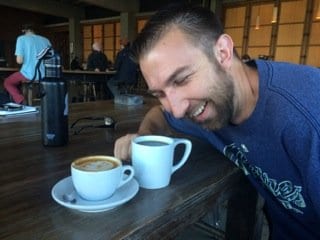
We Experiment with Temperature and Try Todd’s Recipe From the 2016 World Brewers Cup Championship
BY JOSHUA DUSK-PEEBLES
SPECIAL TO BARISTA MAGAZINE
If you’ve watched the World Brewers Cup this year, or any brewers cup or barista championships, you will notice that each competitor spends a significant amount of time describing flavors to the judges that they can expect to taste in the coffee. They are scored on these descriptions and are expected to be very accurate and detailed. On top of that, the judges evaluate the flavors and features of each brew while the coffee is hot (158 °F), warm (104 °F), and cold (86 °F).
The beauty of this system is that it approximates how many coffee consumers actually drink their coffee. Really great coffee is delicious from first to last sip, even if that final ounce has been sitting in a mug, half-forgotten, behind the computer screen, by a student typing furiously away at a term paper for half an hour.
When Todd Goldsworthy ”on his way to 5th place in the World Brewers Cup ”described the flavors produced by the Natural Panama Geisha Hacienda La Esmeralda Montana he brewed on a glass Kalita Wave 185, he told the judges to expect blueberries while it was hot and pineapple as it cooled down. Upon hearing this, I was struck by how much Todd expected the coffee to change as it cooled. This shift inspired me to use his method to conduct an experiment aimed at tasting the same coffee hot and cold from the same brew at the same time.

Here’s how I did it:
- Heat filtered water to 203 °F
- Place a paper filter in a Kalita Wave 185 and rinse it thoroughly
- Pour out any excess water and ensure the filter sits about half an inch above the bottom of the brewer
- Grind coffee medium coarse (I was around 20 on a Barazta Encore)
- Place 27g ground coffee in the Kalita and gently shake brewer to level it
- Start a timer and spiral pour 40g water for 5 seconds
- At :45, spiral pour 110g water (150g total) in 12 seconds
- At 1:15, spiral pour 100g water (250g total) in 12 seconds
- At 2:00, spiral pour 100g water (350g total) in 12 seconds
- Brew should finish at 3:00 (adjust grind to accomplish this)

Once you are done brewing, stir your coffee well and pour one-quarter of it into a large unheated ceramic mug. Give it a little swirl to maximize contact between the hot liquid and the cool surface. The smaller amount will cool especially quickly because it is not insulated by the rest of the hot coffee. Shortly after pouring, you will have two identically brewed cups of coffee at drastically different temperatures.
Taste the two cups side-by-side and pay attention to the differences. Which is sweeter? Are the flavors very different from each other? Does one have more flavor or different flavors?

This method is easily translatable to any brew method and any coffee. In fact, utilizing it when brewing any new coffee will help you be able more quickly œdial in because it immediately exposes any undesirable flavors that would otherwise be masked by a hotter coffee. Even better, it gives you a more complete picture of the potential flavors the coffee can produce. Being able to explain those nuances to your customers in a very accurate and detailed way might just win you a few points of your own.
ABOUT THE AUTHOR
Joshua Dusk-Peebles is a lifelong explorer, experimenter, and learner. He enjoys nothing more than sharing what he is learning with other people. When he was young, he would get legitimately angry if his dad forgot to let him smell the coffee every time a new bag was opened. Unfortunately, the much less pleasant corresponding beverage kept him away from coffee until his 30s, when he smelled and then tasted a well-handled natural process Ethiopia Yirgacheffe, and everything made sense again. He plans on getting his own new-born son started much sooner. He can be reached at dusk.peebles@yahoo.com or found online at duskcoffee.com.



Hi Chris,
In my experience, ensuring that your filter fits in such a way as to create this space provides consistency in the drawdown time with the glass Kalita 185. If it is not there, an additional variable can be introduced in the form of suction that is sometimes created by the water sticking between the filter and the flat smooth bottom of the brewer.
The addition of coffee does push the filter down a bit, as does the weight of the poured water but there should still be some space between the bottom of the filter and the bottom of the brewer.
I hope that is helpful for understanding my reasoning. Of course, I encourage you to conduct your own comparative experiment and brew according to whatever result you find most beneficial and consistent!
Wow, two different flavors in same coffee. Nice to see how you play with temperature for different flavor. Will try myself..
After pouring out the rinse water : ” Ensure filter sits about 1/2 inch above the bottom of the river “. I’m confused by this. Is this so the filter drains completely? Because the filter is going to drop down after the grounds are put in
Interesting read. There’s so much that goes in to making the perfect cup of coffee!